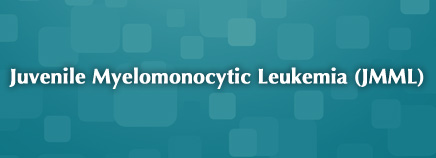
About Leukemia
Leukemia is a type of cancer that affects the body’s white blood cells (WBCs).
Normally, WBCs help fight infection and protect the body against disease. But in leukemia, WBCs turn cancerous and multiply when they shouldn’t, resulting in too many abnormal WBCs. These cells then interfere with the body’s ability to function normally.
Juvenile myelomonocytic leukemia (JMML) is a rare childhood cancer that usually happens in children younger than 2 years old. In JMML, too many myelocytes and monocytes (two types of WBCs) are produced from immature blood stem cells called blasts. These myelocytes, monocytes, and blasts overwhelm the normal cells in the bone marrow and other organs, causing the symptoms of JMML.
Causes
The cause of JMML is unknown, but doctors do know that certain medical conditions — such as neurofibromatosis type 1 and Noonan syndrome — can make a child more likely to develop it.
Signs and Symptoms
JMML tends to progress slowly, so at first a child may have few if any symptoms. In fact, symptoms can take months or even years to develop.
The symptoms of all types of leukemia are generally the same and include:
- fatigue (tiredness) and weakness
- swollen lymph nodes
- recurrent infections (such as bronchitis or tonsillitis)
- fever
- easy bruising
- bone and joint pain
- abdominal pain (caused by abnormal blood cells building up in organs like the kidneys, liver, and spleen)
- swelling of the spleen and abdomen
Diagnosis
A doctor who suspects a child has leukemia may order tests that include:
- Blood tests. Tests such as a complete blood count, liver and kidney function panels, and blood chemistries can give important information about the number of normal blood cells in the body and how well the organs are functioning. The blood cells are viewed under a microscope to check for abnormal shapes or sizes.
- Bone marrow aspiration. In this procedure, the doctor inserts a needle into a large bone, usually the hip, and removes a small amount of bone marrow to examine it for abnormal cells.
- Imaging studies. These may include an X-ray, CT scan, MRI, or ultrasound to check for an enlarged spleen or liver, and also to rule out any other possible causes of a child’s symptoms.
- Lumbar puncture. Also called a spinal tap, this procedure uses a hollow needle to remove a small amount of cerebrospinal fluid (CSF), the fluid surrounding the brain and spinal cord, for examination in a lab.
- Flow cytometry tests. Using markers on leukemia cells collected from the blood, bone marrow, and/or CSF, doctors can determine the type of leukemia a child has. This is important because treatments may vary according to the type of leukemia.
- Chromosomal tests. Analyzing DNA from the blood or bone marrow is another way that doctors can learn which type of leukemia a child has.
- Tissue typing or HLA (human leukocyte antigen) typing. If a child needs a stem cell transplant (also called a bone marrow transplant), this test helps doctors find a suitable stem cell donor. It works by comparing the proteins on the surface of a child’s blood cells with the proteins on a potential donor’s cells. The more HLA (human leukocyte antigen) markers a child and donor share, the greater the chance that a transplant will be successful.
Treatment
Chemotherapy (the use of drugs to kill cancer cells) may be used to temporarily control JMML. However, effective treatment of JMML usually requires a stem cell (bone marrow) transplant.
This procedure involves destroying cancer cells and normal bone marrow and immune system cells with high-dose chemotherapy and then re-introducing healthy donor stem cells into the body. The new stem cells can rebuild a healthy blood supply and immune system.
Even though these therapies are the treatment of choice for kids with JMML, the disease remains difficult to cure. Researchers are looking into the use of alternative treatments, like molecular-targeted therapies (medicines that slow the growth of cancer cells by blocking certain molecules or proteins that help cancer cells grow) and immunotherapies (medicines that mark cancer cells so that the body’s immune system can find the cells and remove them from the body).
Coping
Being told that your child has cancer can be very frightening, and the stress of treating the disease can be overwhelming for any family.
Although you might feel like it at times, you’re not alone. To find support for you or your child, talk to your doctor or a hospital social worker. Many resources can help you get through this difficult time.

